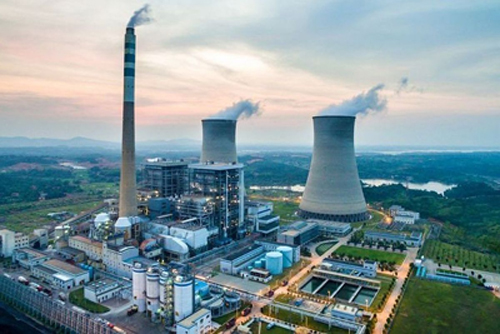The previous record was held by Heysham-2 Unit-8 (610 MW AGR) of UK, an advanced gas-cooled reactor (AGR) which had completed 940 days. In fact, during its record non-stop operation, Kaiga-1 broke two world records. In October this year, the unit set a new world record for continuous operation by a PHWR when it completed its 895th day of continuous operation, surpassing an earlier world record for a PHWR which was set in 1994 by Canada's Pickering unit 7, with 894 days of continuous operation. Continuing its non-stop operation further, Kaiga-1 has now established the 962-day record for all type of reactors globally. During this non-stop run that began on May 13, 2016, Kaiga-1 generated about 5 billion units of electricity at a Plant Load Factor of about 99.3%. The journey of the reactor started more than 18 years ago, with its commercial operation commencing on November 16, 2000.
Located in Karwar taluka of Uttar Kannada district, on the bank of the Kali River, Kaiga Generating Station has four indigenously developed Pressurized Heavy Water Reactors (Kaiga-1 to 4), of 200 MW each, fuelled by domestic natural uranium fuel. Kaiga units-2, 3 and 4 are presently operating, with Kaiga-2 now running continuously for 661 days and marching on.
Till now, three Indian nuclear reactors, namely, Kaiga Generating Station Unit-1, Rajasthan Atomic Power Station (RAPS) Unit-3 (777 days) and RAPS Unit-5 (765 days), have achieved continuous operation of more than two years.
What’s more, Indian nuclear power plants have demonstrated continuous operation for more than 365 days on 28 occasions so far. Besides, the units at Kaiga have operated for more than a year on 12 occasions so far.
The record-breaking feat of Kaiga-1 has not only established India at number one position in longest continuous operation among all types of nuclear power reactors in the world, but also demonstrated the maturity of the Indian nuclear power programme as well as the topmost priority accorded to safety at Indian nuclear power plants.
What makes this feat even more remarkable is the fact that Kaiga-1 is an indigenous Pressurised Heavy Water Reactor (PHWR). It is worth noting here that India faced an international technology denial regime for 34 years, following Pokhran-I in 1974. Despite this embargo, India continued its quest to harness nuclear technology for peaceful purposes such as electricity generation as well as myriads of non-power applications. The continued development of PHWR technology during these years is a testimony to the resilience of Indian scientists and engineers, who worked diligently and tirelessly to master this reactor technology indigenously. The results of this sustained effort is amply reflected in the pre-eminence of NPCIL in the design, construction and operation of PHWRs with unprecedented levels of efficiency and safety. Another notable advantage that has emerged out of this endeavor is the simultaneous rise in the capacities and capabilities of Indian industry partners, which have gained a lot of experience and developed advanced engineering capabilities as a result of synergistic partnership forged between public enterprises and the private sector. The culmination of this fruitful partnership is echoed in the sustained expansion of nuclear power in India.
Kaiga Generating Station produces clean, environment-friendly electricity and the huge biodiversity existing around the nuclear power plant is an example of the harmonious co-existence of nuclear power with nature. The power plant exemplifies the environment-friendly nature of nuclear power plants. Nature abounds in full bloom in the environs of the plant, with more than 250 bird species finding a peaceful place to thrive here, which demonstrates the clean, pollution-free operation of the nuclear power plant. The secret to this nature-friendly operation primarily lies in the manner in which nuclear power plants generate electricity. Nuclear power reactors convert a very small mass of nuclear fuel into a huge amount of energy to generate electricity. Since this conversion does not involve any chemical combustion, there are no toxic gases or greenhouse gases emitted, and the environment is not harmed in any way.
The PHWR technology has several built-in safety features. Safety is one of the foremost priorities for nuclear power plants. It is a testimony to this rigorous regime that in about 5 decades of commercial operation of Indian nuclear power plants, there has not been a single incident involving any exposure to the public beyond the safe prescribed limits.
KGS has established a Nature Club under the aegis of Environment Stewardship Programme – NPCIL’s voluntary nature conservation programme. Under this initiative, KGS creates awareness about the safe operation of nuclear power plants by periodically organising various programmes to educate the public about nature conservation and the benign nature of nuclear power.
In addition, NPCIL conducts various public awareness activities, like exhibitions, lectures, seminars, workshops, etc. Also, visits of students, media and members of public to power plant sites are organised to make them aware about various positive aspects of nuclear power, including safety to environment and public. Besides, NPCIL ensures inclusive growth of local communities through education, health care and infrastructure development as part of corporate social responsibility.
KGS is expanding beyond its present four reactors. Two more indigenous reactors are to be set up at the site – Kaiga-5 and 6 (2x700 MW PHWRs) – which have been accorded administrative approval and financial sanction by the Government of India.
At present, NPCIL operates twenty-two reactors, with a capacity of 6780 MW (including the 100 MW RAPS-1 reactor under extended shutdown) and has eight reactors with a capacity of 6200 MW under construction. Work has also been initiated on twelve more reactors (9000 MW), which have been accorded administrative approval and financial sanction by the Government of India. With this, nuclear power generation in the country is poised for a sharp growth ahead for long term requirement of electricity through clean, green and safe way.

The last day of the year 2018 witnessed historic day for Indian nuclear power programme. On that day, an indigenous nuclear power reactor established a new world record for longest continuous operation. The reactor which achieved this distinction was the 220 MW Unit-1 of Kaiga Generating Station (KGS) located in Karnataka. Kaiga-1 created a historic world record for continuous operation of 962 days. This is the longest run ever any nuclear power reactor has operated in one single stretch. This record was achieved on December 31, 2018, with Kaiga-1 reactor having operated non-stop for over 31 months. The reactor was shut down at around 2300 hrs to take up inspections and maintenance activities. During this planned shutdown, the reactor unit will undergo various maintenance activities, inspections and regulatory clearances, after which it will be restarted.
Thursday, March 14, 2019



